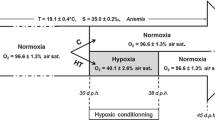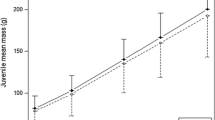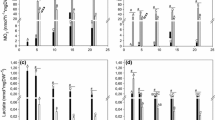Abstract
Oxygen availability is highly variable during salmonid incubation in natural redds and also in aquaculture incubation systems. Hypoxia generally decreases growth and aerobic metabolism prior to hatching, in parallel with eliciting physiological modifications that enhance oxygen delivery. However, it is less-well known whether developmental hyperoxia can drive the opposite effect. Moreover, there is insufficient understanding of stage-specific developmental windows during which ambient oxygen availability may be of greater or lesser impact to incubating embryos. Here, we tested the effects of hypoxia (50% dissolved oxygen: DO, % air saturation) and hyperoxia (150% DO) on the growth, routine aerobic metabolism (\(\dot {M}{{\text{O}}_{{\text{2rout}}}}\)) and hypoxia tolerance (O2crit) of Atlantic salmon (Salmo salar) during seven developmental windows throughout incubation. Embryos exposed to hyperoxia (150% DO) did not differ from the normoxic group in growth, \(\dot {M}{{\text{O}}_{{\text{2rout}}}}\) or O2crit at any developmental window. In contrast, embryos exposed to hypoxia grew slower and had a lower \(\dot {M}{{\text{O}}_{{\text{2rout}}}}\), but had higher hypoxia tolerance (lower O2crit) than normoxic and hyperoxic counterparts. Interestingly, these differences were only apparent when the embryos were measured prior to hatching. Larvae (alevins) incubated in hypoxia following hatching grew similarly to normoxia-incubated alevins. Our results provide evidence that Atlantic salmon embryos are most sensitive to hypoxia prior to hatching, probably due to increasing (absolute) oxygen requirements concurrent with restricted oxygen diffusion through the egg. Moreover, the similarities between normoxia- and hyperoxia-incubated salmon demonstrate that embryos are not oxygen-limited under normoxic conditions.




Similar content being viewed by others
References
Alderdice D, Wickett W, Brett J (1958) Some effects of temporary exposure to low dissolved oxygen levels on Pacific salmon eggs. J Fish Res Board Can 15(2):229–250
Anttila K, Dhillon RS, Boulding EG, Farrell AP, Glebe BD, Elliott JAK, Wolters WR, Schulte PM (2013) Variation in temperature tolerance among families of Atlantic salmon (Salmo salar) is associated with hypoxia tolerance, ventricle size and myoglobin level. J Exp Biol 216(7):1183–1190. https://doi.org/10.1242/Jeb.080556
Bianchini K, Wright PA (2013) Hypoxia delays hematopoiesis: retention of embryonic hemoglobin and erythrocytes in larval rainbow trout, Oncorhynchus mykiss, during chronic hypoxia exposure. J Exp Biol 216(23):4415–4425. https://doi.org/10.1242/jeb.083337
Billard R, Jensen JOT (1996) Gamete removal, fertilization and incubation. In: Pennell W, Barton BA (eds) Principles of salmonid culture, vol 29. Elsevier, The Netherlands, pp 291–364. https://doi.org/10.1016/S0167-9309(96)80008-1
Burggren WW, Reyna KS (2011) Developmental trajectories, critical windows and phenotypic alteration during cardio-respiratory development. Respir Physiol Neurobiol 178(1):13–21. https://doi.org/10.1016/j.resp.2011.05.001
Ciuhandu CS, Stevens ED, Wright PA (2005) The effect of oxygen on the growth of Oncorhynchus mykiss embryos with and without a chorion. J Fish Biol 67(6):1544–1551. https://doi.org/10.1111/j.1095-8649.2005.00856.x
Ciuhandu CS, Wright PA, Goldberg JI, Stevens ED (2007) Parameters influencing the dissolved oxygen in the boundary layer of rainbow trout (Oncorhynchus mykiss) embryos and larvae. J Exp Biol 210(8):1435–1445. https://doi.org/10.1242/jeb.02754
Dejours P (1981) Principles of comparative respiratory physiology, Second edn. Elsevier North-Holland Biomedical Press, Amsterdam
Dhiyebi HA, O’Donnell MJ, Wright PA (2013) Water chemistry in the microenvironment of rainbow trout Oncorhynchus mykiss embryos is affected by development, the egg capsule and crowding. J Fish Biol 82(2):444–457. https://doi.org/10.1111/j.1095-8649.2012.03491.x
Dimichele L, Taylor MH (1980) The environmental control of hatching in Fundulus heteroclitus. J Exp Zool 214(2):181–187. https://doi.org/10.1002/jez.1402140209
Elliott N, Kube P (2009) Development and early results of the Tasmanian Atlantic salmon breeding program. Proc Assoc Advmt Anim Breed Genet 18:362–365
Eme J, Mueller CA, Manzon RG, Somers CM, Boreham DR, Wilson JY (2015) Critical windows in embryonic development: Shifting incubation temperatures alter heart rate and oxygen consumption of Lake Whitefish (Coregonus clupeaformis) embryos and hatchlings. Comp Biochem Physiol Part A Mol Integr Physiol 179:71–80. https://doi.org/10.1016/j.cbpa.2014.09.005
Fox J, Weisberg S (2011) An R companion to applied regression, Second edn. Sage, Thousand Oaks
Garside ET (1959) Some effects of oxygen in relation to temperature on the development of lake trout embryos. Can J Zool 37(5):689–698. https://doi.org/10.1139/z59-069
Gnaiger E, Ortner M, Rieger GE, Salvenmoser W (1987) Aerobic and anoxic metabolism in salmonid embryos: microcalorimetry, respirometry and mitochondrial changes. Am Zool 27(4):31A
Gorodilov YN (1996) Description of the early ontogeny of the Atlantic salmon, Salmo salar, with a novel system of interval (state) identification. Environ Biol Fishes 47(2):109–127. https://doi.org/10.1007/Bf00005034
Greig SM, Sear DA, Carling PA (2007) A review of factors influencing the availability of dissolved oxygen to incubating salmonid embryos. Hydrol Process 21(3):323–334. https://doi.org/10.1002/hyp.6188
Hamor T, Garside ET (1976) Developmental rates of embryos of Atlantic salmon, Salmo salar L. in response to various levels of temperature, dissolved oxygen, and water exchange. Can J Zool 54(11):1912–1917. https://doi.org/10.1139/z76-221
Hamor T, Garside ET (1977) Size relations and yolk utilization in embryonated ova and alevins of Atlantic salmon Salmo salar L. in various combinations of temperature and dissolved oxygen. Can J Zool 55(11):1892–1898. https://doi.org/10.1139/z77-242
Hamor T, Garside ET (1979) Hourly and total oxygen consumption by ova of atlantic salmon, Salmo salar L., during embryogenesis, at two temperatures and three levels of dissolved oxygen. Can J Zool 57(6):1196–1200. https://doi.org/10.1139/Z79-152
Latham KE, Just JJ (1989) Oxygen availability provides a signal for hatching in the rainbow trout (Salmo gairdneri) embryo. Can J Fish Aquat Sci 46(1):55–58. https://doi.org/10.1139/f89-008
Lenth RV (2016) Least-squares means: The R package lsmeans. J Stat Softw 69(1):1–33. https://doi.org/10.18637/jss.v069.i01
Miller SC, Reeb SE, Wright PA, Gillis TE (2008) Oxygen concentration in the water boundary layer next to rainbow trout (Oncorhynchus mykiss) embryos is influenced by hypoxia exposure time, metabolic rate, and water flow. Can J Fish Aquat Sci 65(10):2170–2177. https://doi.org/10.1139/F08-123
Muggeo VMR (2008) segmented: an R package to fit regression models with broken-line relationships. R News 8(1):20–25
Polymeropoulos ET (2013) The effects of oxygen and temperature on the physiology of hatching stage Atlantic salmon. University of Tasmania, Hobart
Polymeropoulos ET, Elliott NG, Frappell PB (2017) Hypoxic acclimation leads to metabolic compensation after reoxygenation in Atlantic salmon yolk-sac alevins. Comp Biochem Physiol A: Mol Integr Physiol 213:28–35. https://doi.org/10.1016/j.cbpa.2017.08.011
R Core Team (2016) R: a language and environment for statistical computing. 3.3.1 edn. R Foundation for Statistical Computing, Vienna
Richards JG (2009) Metabolic and molecular responses of fish to hypoxia. In: Richards JG, Farrell AP, Colin JB (eds) Fish physiology, vol Hypoxia. vol 27. Academic Press, pp 443–485. https://doi.org/10.1016/S1546-5098(08)00010-1
Richards JG (2010) Metabolic rate suppression as a mechanism for surviving environmental challenge in fish. In: Arturo Navas C, Carvalho JE (eds) Aestivation: molecular and physiological aspects. Springer Berlin Heidelberg, Berlin, pp 113–139. https://doi.org/10.1007/978-3-642-02421-4_6
Rissanen E, Tranberg HK, Nikinmaa M (2006) Oxygen availability regulates metabolism and gene expression in trout hepatocyte cultures. Am J Physiol Regul Integr Comp Physiol 291(5):R1507–R1515. https://doi.org/10.1152/ajpregu.00025.2006
Robertson CE, Wright PA, Köblitz L, Bernier NJ (2014) Hypoxia-inducible factor- 1 mediates adaptive developmental plasticity of hypoxia tolerance in zebrafish, Danio rerio. Proc R Soc B 281:1786. https://doi.org/10.1098/rspb.2014.0637
Rombough PJ (1988) Growth, aerobic metabolism, and dissolved-oxygen requirements of embryos and alevins of steelhead, Salmo gairdneri. Can J Zool 66(3):651–660. https://doi.org/10.1139/Z88-097
Rombough PJ, Ure D (1991) Partitioning of oxygen uptake between cutaneous and branchial surfaces in larval and young juvenile chinook salmon Oncorhynchus tshawytscha. Physiol Zool 64(3):717–727. https://doi.org/10.2307/30158203
Spicer JI, Burggren WW (2003) Development of physiological regulatory systems: altering the timing of crucial events. Zoology 106(2):91–99
Velsen FPJ (1980) Embryonic development in eggs of sockeye salmon, Oncorhynchus nerka. Ottawa
Wells P, Pinder A (1996) The respiratory development of Atlantic salmon. II. Partitioning of oxygen uptake among gills, yolk sac and body surfaces. J Exp Biol 199(12):2737–2744
Yaqoob N, Schwerte T (2010) Cardiovascular and respiratory developmental plasticity under oxygen depleted environment and in genetically hypoxic zebrafish (Danio rerio). Comp Biochem Integr Physiol 156(4):475–484. https://doi.org/10.1016/j.cbpa.2010.03.033
Youngson AF, Malcolm IA, Thorley JL, Bacon PJ, Soulsby C (2004) Long-residence groundwater effects on incubating salmonid eggs: low hyporheic oxygen impairs embryo development. Can J Fish Aquat Sci 61:2278–2287. https://doi.org/10.1139/f04-217
Acknowledgements
We would like to thank the Salmon Enterprises of Tasmania (SALTAS) hatchery staff for supplying eggs and assistance monitoring experimental systems. This research was supported financially by SALTAS. An Australian Government Research Training Program Scholarship was awarded to A.T.W. All experiments carried out in this study were performed in compliance with the University of Tasmania Ethics Committee (Hobart, Australia) under ethics permit A0013794.
Author information
Authors and Affiliations
Corresponding author
Additional information
Communicated by G. Heldmaier.
Publisher’s Note
Springer Nature remains neutral with regard to jurisdictional claims in published maps and institutional affiliations.
Electronic supplementary material
Below is the link to the electronic supplementary material.
Rights and permissions
About this article
Cite this article
Wood, A.T., Clark, T.D., Elliott, N.G. et al. Physiological effects of dissolved oxygen are stage-specific in incubating Atlantic salmon (Salmo salar). J Comp Physiol B 189, 109–120 (2019). https://doi.org/10.1007/s00360-018-1199-5
Received:
Revised:
Accepted:
Published:
Issue Date:
DOI: https://doi.org/10.1007/s00360-018-1199-5




